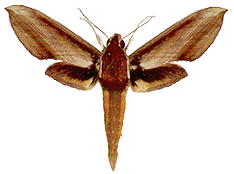|
Theretra nessus Drury
Sphinx nessus Drury, 1773, Illustr. Ex. Ins., 2: 46.
Theretra nessus Drury; Rothschild & Jordan, 1903: 765.
|

Theretra nessus 
(.65
natural size)
|
Diagnosis. The broad irregular yellow band of the hindwing, the
yellow-flanked, green abdomen and the green costal zone of the forewing
interacting irregularly with the pale postmedial band distinguish this
species.
Geographical range. Japan, Indo-Australian tropics to New Caledonia;
introduced to Hawaii.
Habitat preference. T. nessus is taken frequently with light traps at all
altitudes from the lowlands to 2600m.
Biology. The mature larva is variable, usually green or yellowish brown
(Bell & Scott, 1937; Dupont & Roepke, 1941), with white
dorsolateral and (green form only) dorsal lines, Bell & Scott
illustrate the brown form as dorsally more yellowish brown. The ocellus on
A1 is obliquely oval, white, edged blue to the interior; a much smaller
ocellus occurs within the dorsolateral stripe on A2. All abdominal
segments in this brown form have triangular blue patches to the dorsal
side of the dorsolateral stripe. Oblique bars occur laterally from A2
backwards, white in the green form and darker brown in the brown form.
Recorded host-plants (Bell & Scott, 1937; Pholboon, 1965; Yunus &
Ho, 1980; Miyata, 1983) are: Amaranthus (Amaranthaceae); Impatiens
(Balsaminaceae);
Citrullus (Cucurbitaceae); Arachis (Leguminosae); Boerhavia
(Nyctaginaceae);
Knoxia, Morinda, Oldenlandia, Spermacoce (Rubiaceae); Glossostigma
(Scrophulariaceae);
Camellia (Theaceae).
<<Back
>>Forward <<Return
to Contents page
|

